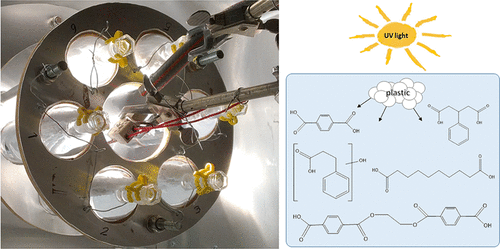Identification of Chain Scission Products Released to Water by Plastic Exposed to Ultraviolet Light
Berit Gewert, Merle Plassmann, Oskar Sandblom, Matthew MacLeod
文献索引:10.1021/acs.estlett.8b00119
全文:HTML全文
摘要

Buoyant plastic in the marine environment is exposed to sunlight, oxidants, and physical stress, which may lead to degradation of the plastic polymer and the release of compounds that are potentially hazardous. We report the development of a laboratory protocol that simulates the exposure of plastic floating in the marine environment to ultraviolet light (UV) and nontarget analysis to identify degradation products of plastic polymers in water. Plastic pellets [polyethylene, polypropylene, polystyrene, and poly(ethylene terephthalate)] suspended in water were exposed to a UV light source for 5 days. Organic chemicals in the water were concentrated by solid phase extraction and then analyzed by ultra-high-performance liquid chromatography coupled to high-resolution mass spectrometry using a nontarget approach with a C18 LC column coupled to a Q Exactive Orbitrap HF mass spectrometer. We designed a data analysis scheme to identify chemicals that are likely chain scission products from degradation of the plastic polymers. For all four polymers, we found homologous series of low-molecular weight polymer fragments with oxidized end groups. In total, we tentatively identified 22 degradation products, which are mainly dicarboxylic acids.
|
Modeling Secondary Organic Aerosol Production from Photosens...
2018-04-06 [10.1021/acs.estlett.8b00101] |
|
Reductive Defluorination of Branched Per- and Polyfluoroalky...
2018-04-06 [10.1021/acs.estlett.8b00122] |
|
Kaolin Alleviates Graphene Oxide Toxicity
2018-04-06 [10.1021/acs.estlett.8b00135] |
|
Estimating the Transfer Range of Plasmids Encoding Antimicro...
2018-04-05 [10.1021/acs.estlett.8b00105] |
|
Biotransformation of AFFF Component 6:2 Fluorotelomer Thioet...
2018-04-04 [10.1021/acs.estlett.8b00148] |